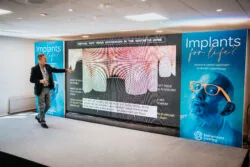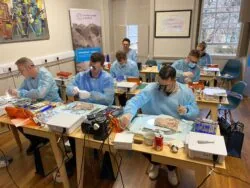Predictable guided immediate implant placement in the aesthetic zone

Nick Fahey gives us a teaser into his recent webinar where he discusses the fundamentals of the prosthetically-driven treatment modality of immediate placement in the aesthetic zone.
Planning with dental implants has evolved exponentially in the last few years and using advanced technology for the concept of “reverse planning” and prosthetically-driven guided surgery is not new. Despite the advent of 3D CBCT planning software and the boom of virtual guided surgery in the early-mid noughties it’s only now that we’re starting to see implant dentists become more accustomed to the benefits of guided surgery when striving for correct positioning and predictability in the aesthetic zone.
Essentially, good treatment planning is the cornerstone of excellent implant dentistry. A meticulous diagnosis and accurately placed dental implants are critically important to obtaining a predictable outcome.
Guided surgery: a brief history
As a prosthodontist, I’ve always been interested in restoratively driven placement of dental implants. Having placed over 5,000 implants and been using guided surgery for over 20 years I believe it’s important for me to disseminate my knowledge and share my expertise in this field.
In the early 2000s, we were making very prescriptive restoratively driven guides. The problem with this was that there was often no three-dimensional information available regarding the bone.
I was also following all the recommended techniques from the experts and industry alike and was still finding that I didn’t have the consistency I wanted with my implant placements. I was putting my implants in what I thought looked like the right place. But then when I got the crown back from the laboratory, I would sit there and think “that doesn’t quite look like it’s in the place I thought it was!” To be honest, before I started using guided surgery, I was rarely entirely happy with my implant placements.
When I began to wonder about this I came up with the theory that – “when the placement of the implant looked a little bit wrong, it was often right – and when it looked right, it was often a little bit wrong!” Now, I am not saying when things are clearly not right, they might be fine. This is more subtle than that. What I am saying is that as humans we tend to always want to err towards safety. As an example, for me, that often equated to me placing the implant too palatally, or a little deeper than it should ideally have been located.
With guided surgery, it gives us the ability not to lose our path. When I’m in a situation where I’m in the middle of surgery and I feel unsure about the positioning, the first thing I do is look at my case planning on the large TV screen I have in my surgical suite. If I believe the planning is right, I tend to trust in it. And over time this philosophy has served me better than adjusting things on the fly.
The power of planning and virtual surgery
Over the past 10 years I’ve used guided surgery on almost all of my implant cases and the reason for this is that I am confident that I get a much tighter tolerance on what I believe is an ideal implant placement. Ultimately, if we can put the implant in the right place, we have a fighting chance that we can achieve the ideal aesthetic for the patient.
Virtual implant treatment planning allows for careful and comprehensive treatment planning prior to implant therapy, which then enhances and improves treatment outcomes. Prosthodontic or restoratively-driven planning enables optimal implant positioning to be realised, relative to the final prosthesis. Digital technology allows for better planning of the prosthesis, the abutments and implant position prior to surgery through the use of powerful and complex implant planning software.
According to Prof. Istvan Urban, ‘Often the leading reasons for problems with dental implants including failure can be traced back to the result of the small procedural errors, created on the day of implant surgery.’
So, like the driver of the bobsled at the Olympic games – when you see them going through and rehearsing the track in their mind, so they know exactly where to brake and how high up the wall to go, the dentist who employs guided surgery to place their dental implants, has already performed the implant surgery in their head and virtually when planning the case; so has to have worked out any potential pressure points and risks before performing the surgery.
Before I do a big surgery, I tend to get up early that morning and go for a walk with the dogs where I run through the surgery in my mind as I have planned it. Then when I go and do the surgery, I know where I’m going to make my incisions, what type of flaps I will be using and even things like which side I’m going to start on first, as this has all been decided prior to me stepping into the room.
From a strategic case management aspect, this technique is known as a pre-mortem – an analysis of potential failure before it happens. This prospective hindsight approach allows us to identify pressure points before we commence, which I think we can all agree is better than just reacting as the treatment progresses.
Workflow of guided surgery
A recipe for predictable implant placement using guided surgery is a straightforward 4-step process, where we incorporate easily obtained digital information which is transposed into planning software to allow us to generate a surgical guide and other customised medical devices.
- Data acquisition – We start with taking a 3-dimensional x-ray and scan of the intraoral situation i.e., a CBCT + IOS scan. This is used to identify the hard and soft tissue and to make a diagnostic wax-up. We then send this info off to the laboratory or third party.
- Planning– The 3D data is imported into the planning software to create the dataset that will be used for the virtual surgery. Usually, this step can be done by the laboratory or third party. From here they will “match” the data to create the diagnostic wax-up and implant planning, which after review from the clinician can be signed off for surgical production.
- Guide production – Create/mill the surgical guide. This can be done by the dentist, laboratory or third party.
- Surgical procedure – The dentist now has the surgical template and guided instruments to carry out the surgical procedure.
The digital revolution is upon us, and visual aids are very important to communicate with dentists, laboratories and patients alike. Quite simply, when we take conventional records, I believe it cannot give us the information that we can get from a three-dimensional x-ray or by doing a robust virtual surgery.
Conclusion
Essentially, with guided surgery, we can know what we’re doing beforehand, and this is a key aspect for the power of doing the planning and the virtual surgery. When going through a process of understanding how to use guided surgery it teaches you so much more about how to plan your implant cases, i.e., shows you pressure points in surgery and allows you to go into the treatment more relaxed and confident.
To hear more about my views and experience on guided surgery please take a look at the following:
- Webinar – Watch the full webinar here Predictable guided immediate implant placement in the aesthetic zone
- Book – My first book ‘Guided Surgery – Making Implant Placement Simpler’ will be launching end of 2022.
- Event – I will be speaking at the BioHorizons Camlog UK & Ireland Symposium – Implants for life; a patient-centric approach to dental implantology in September 2022, and chairing the ‘Treatment planning protocols for lifelong implants’ session where there will be an honest debate around implants.
For more information about BioHorizons Camlog products and solutions visit www.theimplantrevolution.co.uk or contact your local Territory Manager here.







